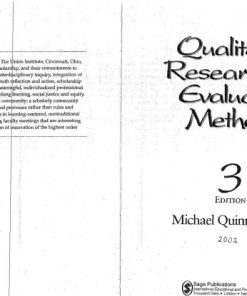(Ebook PDF) Qualitative Research Methods 1st edition by Sarah Tracy 1118378814 9781118378816 full chapters
$50.00 Original price was: $50.00.$25.00Current price is: $25.00.
Authors:Sarah J. Tracy , Series:Education [299] , Author sort:Tracy, Sarah J. , Languages:Languages:eng , Published:Published:May 2013 , Publisher:Wiley
Qualitative Research Methods 1st edition by Sarah J. Tracy – Ebook PDF Instant Download/DeliveryISBN: 1118378814, 9781118378816
Full download Qualitative Research Methods 1st edition after payment.

Product details:
ISBN-10 : 1118378814
ISBN-13 : 9781118378816
Author : Sarah J. Tracy
Qualitative Research Methods is a comprehensive, all-inclusive resource for the theory and practice of qualitative/ethnographic research methodology.
Serves as a “how-to” guide for qualitative/ethnographic research, detailing how to design a project, conduct interviews and focus groups, interpret and analyze data, and represent it in a compelling manner
Demonstrates how qualitative data can be systematically utilized to address pressing personal, organizational, and social problems
Qualitative Research Methods 1st Table of contents:
CHAPTER 1 Developing contextual research that matters
Overview and introduction
Three core qualitative concepts: self-reflexivity, context, and thick description
Self-reflexivity
Context
Thick description
A phronetic approach: doing qualitative research that matters
Strengths of qualitative research
Foci of qualitative research
Understanding the self
Understanding relationships
Understanding groups and organizations
Understanding cultures
Understanding mediated and virtual contexts
Moving from ideas to sites, settings, and participants
EXERCISE 1.1 Field/site brainstorm
Sources of research ideas
CONSIDER THIS 1.1 Sources of research ideas
Compatibility, suitability, yield, and feasibility
RESEARCHER’S NOTEPAD 1.1 Feasibility challenges with hidden populations
TIPS AND TOOLS 1.1 Factoring the ease of fieldwork
Moving toward a research question
RESEARCHER’S NOTEPAD 1.2 Published examples of research questions
FOLLOWING, FORGETTING, AND IMPROVISING
In summary
EXERCISE 1.2 Three potential field sites
CHAPTER 2 Entering the conversation of qualitative research
The nature of qualitative research
Inductive/emic vs. deductive/etic approaches
Action and structure
CONSIDER THIS 2.1 Why am I standing in line?
EXERCISE 2.1 Action vs. structure
Comparing qualitative and quantitative methods
Key characteristics of the qualitative research process
Gestalt
Bricolage
The funnel metaphor
Sensitizing concepts
Key definitions and territories of qualitative research
Historical matters
The early days
Ethically problematic research and the creation of the IRB
Recent history
Current controversies
In summary
EXERCISE 2.2 Research problems and questions
CHAPTER 3 Paradigmatic reflections and theoretical foundations
CONSIDER THIS 3.1 A paradigm parable
Paradigms
Positivist and post-positivist paradigm
Interpretive paradigm
EXERCISE 3.1 Verstehen/understanding
Critical paradigm
Postmodern/poststructuralist paradigm
CONSIDER THIS 3.2 Whose stylistic rules?
Paradigmatic complexities and intersections
EXERCISE 3.2 Paradigmatic approaches
Theoretical approaches that commonly use qualitative methods
Geertz’s interpretivism and thick description
Symbolic interaction
CONSIDER THIS 3.3 How do I know myself?
Ethnography of communication
Feminism
Participatory action research
Sensemaking
Structuration
In summary
CHAPTER 4 Fieldwork and fieldplay: Negotiating access and exploring the scene
A participant observation primer
Knock, knock, knocking on participants’ doors: negotiating access
Confessional tales of getting in
Riding my mentor’s coattails: Citywest 911 emergency call-takers
Becoming a full participant: Radiant sun cruise ship
Accessing a closed organization: women’s minimum and Nouveau jail
Do some homework before approaching the scene
RESEARCHER’S NOTEPAD 4.1 Contact information log
Please don’t reject me! Seeking research permission
RESEARCHER’S NOTEPAD 4.2 Sample access proposal
Negotiating access to a virtual site
Abandoning the ego, engaging embodiment, embracing liminality
EXERCISE 4.1 Self-identity audit
Navigating those first few visits
Encouraging participant cooperation
RESEARCHER’S NOTEPAD 4.3 Initial reactions speak volumes
Seeking informed consent in the scene
TIPS AND TOOLS 4.1 Participant observation tips
Exploratory methods
Briefing interviews and participant information table
RESEARCHER’S NOTEPAD 4.4 Participant information table
Member diaries
Public documents and artifacts
Maps and narrative tours
EXERCISE 4.2 Map and narrative tour
In summary
CHAPTER 5 Proposal writing: Explaining your research to institutional review boards, instructors, su
Getting started with institutional review
The IRB proposal: rationale, instruments, informed consent, and confidentiality
RESEARCHER’S NOTEPAD 5.1 Participant consent letter
RESEARCHER’S NOTEPAD 5.2 Gatekeeper permission letter
Different levels of IRB review
Exempt review
Expedited review
Full-board review
The quirks of IRB
Creating the scholarly research proposal
Title, abstract, and key words
TIPS AND TOOLS 5.1 Research proposal components
Introduction/rationale
Purpose statement
Conceptual cocktail party
Rationale
Literature review/conceptual framework
Research questions/foci
Methods
TIPS AND TOOLS 5.2 What belongs in a qualitative methods section?
Budget/timeline
TIPS AND TOOLS 5.3 What to include in a qualitative project budget
Projected outcomes
In summary
CHAPTER 6 Field roles, fieldnotes, and field focus
Field roles and standpoints of participant observation
Complete participant
Play participant
CONSIDER THIS 6.1 Why “playing” = learning
CONSIDER THIS 6.2 When playing is uncomfortable
Focused participant observer
Complete observer
Writing fieldnotes
Raw records and head notes
Formal fieldnotes
RESEARCHER’S NOTEPAD 6.1 Fieldnote header
Economy versus detail
Showing (and using dialogue) versus telling
Making the familiar strange and the strange familiar
Noticing the data as evidence
CONSIDER THIS 6.3 Noticing the data as evidence
Analytic reflections
TIPS AND TOOLS 6.1 Fieldnote writing tips
Fieldnote wrap-up
Focusing the data and using heuristic devices
FOLLOWING, FORGETTING, AND IMPROVISING
EXERCISE 6.1 Fieldnotes
In summary
CHAPTER 7 Interview planning and design: Sampling, recruiting, and questioning
CONSIDER THIS 7.1 Yin and yang: taijitu
The value of interviews
EXERCISE 7.1 Self-reflexive interviewing
Who, what, where, how, and when: developing a sampling plan
Random samples
Convenience/opportunistic samples
TIPS AND TOOLS 7.1 Sampling plans
Maximum variation samples
Snowball samples
Theoretical-construct samples
Typical, extreme, and critical instance samples
Determining the best sample
Interview structure, type, and stance
Structure of interviews
Interview types
Interview stances
TIPS AND TOOLS 7.2 Interview structure, types and stances
Creating the interview guide
Exercise 7.2 Strategizing interviews
Wording good questions
RESEARCHER’S NOTEPAD 7.1 Research questions versus interview questions
TIPS AND TOOLS 7.3 Interview question types
Interview question types and sequencing
Opening the interview
Generative questions
Directive questions
Closing the interview
Interview question wrap-up
EXERCISE 7.3 Interview guide
In summary
CHAPTER 8 Interview practice: Embodied, mediated, and focus-group approaches
Negotiating access for interviews
Conducting face-to-face interviews
Interview logistics
Why good interviewing is so much more than asking questions
Technologically mediated approaches to interviewing
Strengths of mediated interviews
Disadvantages of mediated interviews
TIPS AND TOOLS 8.1 Mediated interviews: advantages and disadvantages
The focus-group interview
The value of focus groups
When to use focus groups
Planning the logistical details of focus groups
Conducting the focus group
TIPS AND TOOLS 8.2 Planning a focus group
Moderating the focus group
Overcoming common focus group and interviewing challenges
RESEARCHER’S NOTEPAD 8.1 Remedial–pedagogical interviews
EXERCISE 8.1 Role-playing interview challenges in a fishbowl
Transcribing
TIPS AND TOOLS 8.3 Common transcribing symbols
In summary
CHAPTER 9 Data analysis basics: A pragmatic iterative approach
Organizing and preparing the data
Analysis logistics: colors, cutting or computers?
Manual approaches
RESEARCHER’S NOTEPAD 9.1 Manual coding visual display
Computer-aided approaches with everyday software
Data immersion and primary-cycle coding
Focusing the analysis and creating a codebook
RESEARCHER’S NOTEPAD 9.2 Codebook excerpt
CONSIDER THIS 9.1 Focusing the data analysis
Secondary-cycle coding: second-level analytic and axial/hierarchical coding
Synthesizing and making meaning from codes
RESEARCHER’S NOTEPAD 9.3 Analytic memos
RESEARCHER’S NOTEPAD 9.4 Loose analysis outline
FOLLOWING, FORGETTING, AND IMPROVISING
In summary
EXERCISE 9.1 Iterative analysis basics
CHAPTER 10 Advanced data analysis: The art and magic of interpretation
Computer-aided qualitative data analysis software (CAQDAS)
Advanced approaches for analyzing qualitative data
Exemplars and vignettes
Developing typologies
Dramatistic strategy
Metaphor analysis
Visual data displays
RESEARCHER’S NOTEPAD 10.1 Table for organizing dissertation findings
RESEARCHER’S NOTEPAD 10.2 Matrix display
TIPS AND TOOLS 10.1 Flowchart depicting iterative analysis process
Explanation and causality
Discourse tracing
RESEARCHER’S NOTEPAD 10.3 Micro, meso, macro sources
FOLLOWING, THEN FORGETTING THE RULES
In summary
EXERCISE 10.1 Advanced data analysis/interpretation
CHAPTER 11 Qualitative quality: Creating a credible, ethical, significant study
The criteria controversy
TIPS AND TOOLS 11.1 Eight “big-tent” criteria for excellent qualitative research
Worthy topic
Rich rigor
EXERCISE 11.1 Gauging worth and rigor
Sincerity
Self-reflexivity
Transparency
RESEARCHER’S NOTEPAD 11.1 Sincerity word cloud
Credibility
Thick description
Crystallization/triangulation
TIPS AND TOOLS 11.2 Inter-coder reliability
Multivocality
Member reflections
Resonance
Transferability and naturalistic generalization
Aesthetic merit
Significant contribution
EXERCISE 11.2 Gauging significance
Ethical research practice
Procedural ethics
Situational ethics
CONSIDER THIS 11.1 Recruiting difficult populations
CONSIDER THIS 11.2 Situational and relational ethics
Meaningful coherence
FOLLOWING, FORGETTING, AND IMPROVISING
CONSIDER THIS 11.3 The ten lies of ethnography
In summary
CHAPTER 12 Writing Part 1: The nuts and bolts of qualitative tales
Types of tales
The realist tale
Creative, impressionist, and literary tales
RESEARCHER’S NOTEPAD 12.1 Poetic inquiry
The confessional tale
RESEARCHER’S NOTEPAD 12.2 Dialogue as a powerful literary tactic
The archeology of a qualitative essay
Writing the framing material: title, abstract, key words
Writing the introduction, the literature review, and the conceptual framework
Writing the research methodology and method(s)
RESEARCHER’S NOTEPAD 12.3 Methods data display
Writing the findings and analysis
Themes/topics
Chronology/life-story
Convergence/braided narrative
Puzzle explication strategy
Separated text
Layered/messy texts
EXERCISE 12.1 Which writing strategy?
Writing the conclusions and implications
FOLLOWING, FORGETTING, AND IMPROVISING
In summary
CHAPTER 13 Writing Part 2: Drafting, polishing, and publishing
Writing to inquire
How to write qualitative evidence
Choosing the evidence
Rich, luminous, and thick evidence
Structuring the data in sections, paragraphs, and sentences
Formatting qualitative work
Visual representations
RESEARCHER’S NOTEPAD 13.1 Visual representation
Setting yourself up for success by considering the audience first
EXERCISE 13.1 Article format model
TIPS AND TOOLS 13.1 Journals that have published qualitative communication research
Submitting, revising, and resubmitting for journal publication
Git R done: overcoming common writing and submission challenges
How to write a lot
TIPS AND TOOLS 13.2 Steps for writing an ethnography
Addressing common challenges in qualitative writing
FOLLOWING, FORGETTING, AND IMPROVISING
In summary
CHAPTER 14 Qualitative methodology matters: Exiting and communicating impact
Navigating exit from the scene
Give notice and say goodbye
Exits can be emotional
Don’t spoil the scene
Give back
People also search for Qualitative Research Methods 1st:
quantitative and qualitative research methods
quantitative vs qualitative research methods
the sage encyclopedia of qualitative research methods
introduction to qualitative research methods
how to use and assess qualitative research methods












